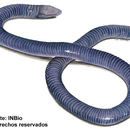en
names in breadcrumbs


Distribucion General:
Oscaecilia osae és una espècie d'amfibis gimnofions de la família Caeciliidae. És endèmica de Costa Rica. Els seus hàbitats naturals inclouen boscos secs tropicals o subtropicales, plantacions, jardins rurals i zones prèviament boscoses ara molt degradades.
Oscaecilia osae és una espècie d'amfibis gimnofions de la família Caeciliidae. És endèmica de Costa Rica. Els seus hàbitats naturals inclouen boscos secs tropicals o subtropicales, plantacions, jardins rurals i zones prèviament boscoses ara molt degradades.
Oscaecilia osae is a species of caecilian in the family Caeciliidae. It is endemic to Costa Rica and is only known from the Golfo Dulce area, on the Pacific Ocean side of Costa Rica.[1][3][4] The specific name osae refers to its type locality, the airstrip at La Sirena, being located on the Osa Peninsula.[2] It is also known as the airstrip caecilia[1] or airstrip caecilian.[3][4]
The holotype, an adult female,[a] measures 382 mm (15.0 in) in total length. The body is highly attenuated;[2][4] the body width is 4–5 mm (0.16–0.20 in).[2] The eyes are not visible. The primary annulus count is high (232), whereas the secondary annuli are completely absent. Scales are small and present from the primary annulus 175. Coloration is uniform lavender, becoming lighter anteriorly and ventrally. The coloration is caused by tiny, closely spaced pinkish-cream punctate glands on darker background; when these become closer together and eventually fuse, they give rise to the more pinkish appearance of the head and ventral region.[2][4]
Oscaecilia osae is a subterranean species that occurs in lowland rainforest at elevations below 240 m (790 ft). There appear not to be major threats to this species, although its distribution and ecology are poorly known. It is well protected by the Corcovado National Park.[1]
Oscaecilia osae is a species of caecilian in the family Caeciliidae. It is endemic to Costa Rica and is only known from the Golfo Dulce area, on the Pacific Ocean side of Costa Rica. The specific name osae refers to its type locality, the airstrip at La Sirena, being located on the Osa Peninsula. It is also known as the airstrip caecilia or airstrip caecilian.
Oscaecilia osae es una especie de anfibio gimnofión de la familia Caeciliidae.
Es endémica de la Península de Osa (Costa Rica): se ha hallado en el parque nacional Corcovado.[2] Se encuentra a una altitud de hasta 240 msnm.
Oscaecilia osae es una especie de anfibio gimnofión de la familia Caeciliidae.
Es endémica de la Península de Osa (Costa Rica): se ha hallado en el parque nacional Corcovado. Se encuentra a una altitud de hasta 240 msnm.
Oscaecilia osae Oscaecilia generoko animalia da. Anfibioen barruko Caeciliidae familian sailkatuta dago, Gymnophiona ordenan.
Oscaecilia osae Oscaecilia generoko animalia da. Anfibioen barruko Caeciliidae familian sailkatuta dago, Gymnophiona ordenan.
Oscaecilia osae est une espèce de gymnophiones de la famille des Caeciliidae[1].
Cette espèce est endémique du Costa Rica[1]. Elle se rencontre jusqu'à 40 m d'altitude dans la péninsule d'Osa[2].
La femelle holotype mesure 382 mm[3].
Son nom d'espèce, composé de osa et du suffixe latin -ensis, « qui vit dans, qui habite », lui a été donné en référence au lieu de sa découverte, la péninsule d'Osa.
Oscaecilia osae est une espèce de gymnophiones de la famille des Caeciliidae.
Oscaecilia osae é uma espécie de anfíbio gimnofiono da família Caeciliidae.
É endémica da Costa Rica.
O seu habitat natural inclui florestas tropicais e subtropicais húmidas de baixas altitudes, plantações, jardins rurais e antigas florestas altamente degradadas.
Oscaecilia osae é uma espécie de anfíbio gimnofiono da família Caeciliidae.
É endémica da Costa Rica.
O seu habitat natural inclui florestas tropicais e subtropicais húmidas de baixas altitudes, plantações, jardins rurais e antigas florestas altamente degradadas.
Oscaecilia osae là một loài lưỡng cư thuộc họ Caeciliidae. Đây là loài đặc hữu của Costa Rica. Môi trường sống tự nhiên của chúng là rừng ẩm vùng đất thấp nhiệt đới hoặc cận nhiệt đới, các đồn điền, vườn nông thôn, và rừng thoái hóa nghiêm trọng.
Oscaecilia osae là một loài lưỡng cư thuộc họ Caeciliidae. Đây là loài đặc hữu của Costa Rica. Môi trường sống tự nhiên của chúng là rừng ẩm vùng đất thấp nhiệt đới hoặc cận nhiệt đới, các đồn điền, vườn nông thôn, và rừng thoái hóa nghiêm trọng.